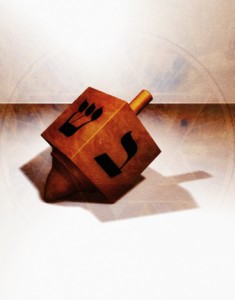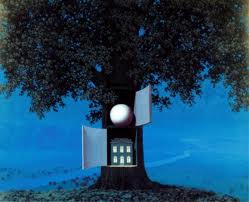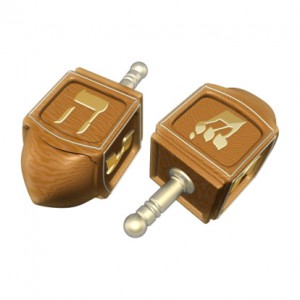Circus of Dreams (Part 23)
By Asher Crispe: December 17, 2012: Category Decoding the Tradition, Inspirations
To Light Up the Night
 Although mountains and fields have a tremendous allure to them, we generally don’t settle there. Besides being outdoor environments that attract us for camping or other short lived excursions, these are not our chosen places for settling in. For that we want a home. Of the three patriarchies, it was Yaakov/Jacob who designated the unique place that mediates transcendence as a ‘house’ (in contrast to Avraham’s/Abraham’s ‘mountain’ and Yitzchak’s/Isaac’s ‘field’). After falling asleep and dreaming of a ladder, Yaakov/Jacob awakens with the realization that (Genesis 28:17) “…this is none other than the house of God, and this is the gate of heaven.” Besides the simple meaning of the text which refers to the site of the future Temple, the esoteric significance of a ‘house,’ being the means of accessing the Divine, necessitates that the whole of existence become ‘homely.’
Although mountains and fields have a tremendous allure to them, we generally don’t settle there. Besides being outdoor environments that attract us for camping or other short lived excursions, these are not our chosen places for settling in. For that we want a home. Of the three patriarchies, it was Yaakov/Jacob who designated the unique place that mediates transcendence as a ‘house’ (in contrast to Avraham’s/Abraham’s ‘mountain’ and Yitzchak’s/Isaac’s ‘field’). After falling asleep and dreaming of a ladder, Yaakov/Jacob awakens with the realization that (Genesis 28:17) “…this is none other than the house of God, and this is the gate of heaven.” Besides the simple meaning of the text which refers to the site of the future Temple, the esoteric significance of a ‘house,’ being the means of accessing the Divine, necessitates that the whole of existence become ‘homely.’
To think through the image of our existential un-homeliness is to run up against the most fundamental characterization of exile. Not feeling at home in the world, being out of joint, being alienated and displaced, are all synonyms for our experience of hostilities in life. We are exposed to the harshness of the most elemental factors with nothing supporting us. Building a home, therefore, amounts to more than just laying in a foundation, walls and a roof. Our purpose, according to the Torah, is to transform all of reality into a home with enough space for dual occupancy so that both humans and the Divine may dwell together.
This home-as-the-world envelopes us all around like the figure of the Samech-circle. While in the mountain-pyramid model, we all have our ‘rank and file’, we are strangers and outlaws on all levels other than our own. Thus most of the pyramid is foreign to us and we are foreign to it. In the somewhat ameliorated field-square we get a taste of what another’s post and position is like–a sampling of all shoes and shoe sizes– but, we can’t fully appreciate each other’s places. Territories, despite a relaxation of border crossings and travel restrictions, remain intact. This is why we must progress still further if we are to fully sweeten the whole of reality. In the encircling-house, I am always at home. There is ample room for everyone inside. Moreover, the strength of such a metaphysical house is that it is able to support all our weight.
 Additional backing for this correspondence between the ‘house’ mentality and the symbol of the circle can be derived from the specifics recorded by Rashi (Genesis 28:11) with respect to the dream experience of Yaakov/Jacob. When he laid down, according to Rashi, Yaakov/Jacob arranged twelve stones ‘around’ [‘saviv’ starting with a Samech] his head. One could say that he configured his ‘head’ or mental space in a circular fashion which would protect him from harmful influences. Moreover, in so doing, by just entering into this place, the ‘earth folded for him [kaftzah lo ha’aretz] ,’ meaning to say that no territory was excluded from his ‘head.’ Wrapping one’s consciousness around all positions would be like forging it into a ‘super-positional’ circle. Housing this ‘eccentricities’ in the mind allows a person to achieve a kind of comprehensive relatability. Dancing around the perspectival circle allows one to move into all positions and advance through all the ‘slices’ of life. In light of this, we might qualify the ‘round-house’ as the model of universal hospitality and omni-directional welcome.
Additional backing for this correspondence between the ‘house’ mentality and the symbol of the circle can be derived from the specifics recorded by Rashi (Genesis 28:11) with respect to the dream experience of Yaakov/Jacob. When he laid down, according to Rashi, Yaakov/Jacob arranged twelve stones ‘around’ [‘saviv’ starting with a Samech] his head. One could say that he configured his ‘head’ or mental space in a circular fashion which would protect him from harmful influences. Moreover, in so doing, by just entering into this place, the ‘earth folded for him [kaftzah lo ha’aretz] ,’ meaning to say that no territory was excluded from his ‘head.’ Wrapping one’s consciousness around all positions would be like forging it into a ‘super-positional’ circle. Housing this ‘eccentricities’ in the mind allows a person to achieve a kind of comprehensive relatability. Dancing around the perspectival circle allows one to move into all positions and advance through all the ‘slices’ of life. In light of this, we might qualify the ‘round-house’ as the model of universal hospitality and omni-directional welcome.
Yaakov/Jacob as our champion of the housing-circle is further made manifest through his offspring. The ‘house’ of Israel is made up of twelve tribes who are the twelve sons of Yaakov/Jacob (whose were prefigured in the 12 stones encircling Yaakov’s/Jacob’s head during the dream). According to Kabbalah, these twelve tribes are related to 12 diagonal lines within the sefirotic tree (the key structure of the dimensions of reality, channels of Divine consciousness and powers of the soul). Hence, the ‘tribal’ mentality regards reality ‘obliquely.’ Social construction of our experience groups us together according to our particular perspectival ‘angle’ of accessing our center of reality. As the progenitor of all of them, he circumscribes the set of all their perspectives whose genesis can be traced back to different ‘turns’ in his own soul.
Nevertheless, of all the sons of Yaakov/Jacob, one in particular is singled out for his extra strong affinity with his father as alluded to in an alternative reading of Genesis 37:2 where the two names appear one right after the other and are thus tied together due to the ‘formal’ absence of grammatical and syntactic breaks in the verse as it is written in a Torah scroll: “This is the history [generations] of Yaakov/Jacob Yosef/Joseph….” Kabbalistically, this is interpreted to mean the the spiritual properties of Yosef/Joseph are most directly linked to those of Yaakov/Jacob his father. The primary genetic trait that is passed from Yaakov/Jacob to Yosef/Joseph is that of the Samech-circle.
As a point of fact,Yosef/Joseph is the only one of the twelve whose name in Hebrew contains the letter Samech. His entire being may be looked upon as an externalization of this seminal ability within his father. Likewise, Yosef/Joseph too surmounts the particular perspectives of his brothers who will eventually be welcomed by him in a new ‘home away from home’ when they seek refuge in Egypt under the aegis of their ‘exceptional’ brother. Though initially unrecognizable, the plot twist that Yosef/Joseph uses transforms even the spiritual antithesis of home into a hospitable dwelling place. Antinomies disappear when the dreamweaver spins the events of our lives into a novel reality.
In conclusion, we can locate each of our models of the triangle, square and circle within the traditional Chanukah game-play with the dreidel. This is no ordinary ‘top.’ The word dreidel stems from the Yiddish word ‘dreyen’ which means ‘to turn.’ In Hebrew, a dreidel is called a sevivon [סביבון] which comes from the word sovev (to surround) and starts with the circular letter Samech. Altogether, the dreidel reflects the ‘game-play’ of reality as a whole which can undergo radical transformation (re/volutions) by our efforts to ‘turn’ events for the better and to put a positive ‘spin’ on things. All this happens in light of the Chanukah candles that enlighten the darkness of the world.
The dreidel may be broken down into three geometric shapes: 1) the cone which forms a tip that comes in contact with the surface it’s spinning on is a ‘mountain-pyramid’ or ‘triangular’ shape [Avraham/Abraham] 2) the body of the dreidel has four sides which makes it our square-field [Yitzchak/Isaac] and finally 3) the spindle or ‘crown’ as it is sometimes called, is the part that we actually take hold of to get the whole thing to spin and is itself usually round like our circle [Yaakov/Jacob]. [Note: I would like extend my appreciation to Matisyahu Miller for pointing this out to me].
 Thus the part that I use to apply force to the entire object transforms both the triangle and the square (tip and body) into a circle. All of the sides are de-differentiated and cannot be distinguished in the midst of a spin cycle. Once the top slows and falls over, a new ‘unexpected’ side of reality can emerge. The same holds true for any inspirational acts (hashra’ah) which surround us and turn our natural progressions or evolutions (histalshilut) and our investment in leaping ahead (hitlabshut) into swift and sudden revolutionary change. The hand that gets a ‘handle’ on things, that tries to take charge of the direction that events are moving in, is that of Yosef/Joseph. Subsequently, we might imagine ourselves playing Yosef’s/Joseph’s role in attaching ourselves to Yaakov/Jacob (the spindle) and then redeeming Avraham/Abraham and Yitzchak/Isaac (the body and tip) at the same time.
Thus the part that I use to apply force to the entire object transforms both the triangle and the square (tip and body) into a circle. All of the sides are de-differentiated and cannot be distinguished in the midst of a spin cycle. Once the top slows and falls over, a new ‘unexpected’ side of reality can emerge. The same holds true for any inspirational acts (hashra’ah) which surround us and turn our natural progressions or evolutions (histalshilut) and our investment in leaping ahead (hitlabshut) into swift and sudden revolutionary change. The hand that gets a ‘handle’ on things, that tries to take charge of the direction that events are moving in, is that of Yosef/Joseph. Subsequently, we might imagine ourselves playing Yosef’s/Joseph’s role in attaching ourselves to Yaakov/Jacob (the spindle) and then redeeming Avraham/Abraham and Yitzchak/Isaac (the body and tip) at the same time.
*Much of the source material for this series was drawn from an essay in Mivchar Shiurei Hahitbonnenut volume 12 by Rabbi Yitzchak Ginsburgh entitled “Sod Ha’iggul” [The Secret of the Circle] pp. 135-164.
http://www.interinclusion.org/inspirations/circus-of-dreams-part-22/
http://www.interinclusion.org/inspirations/circus-of-dreams-part-1/
Circus of Dreams (Part 23),






















;)
;)
;)
;)
;)
;)
;)
;)
;)
;)

I think I get it now. You go into the realm of math to derive new truths about the imagery. I see that you “brought it all home” in this article. The images themselves run the risk of being taken as self-evident and self-contained, or reductionist, but the math lets you find more to bring back to the picture. I still don’t speak the language, but that seems to make sense. It’s an incentive to try to get over my mental block with math.
I didn’t at first realize that this was the last article. I can take a 23-article hint. 😀 Samech’s linkage to circles is too profound to ignore in my project. I’m convinced to treat it like a given, and find a way to reinterpret the “dream”. Thanks.